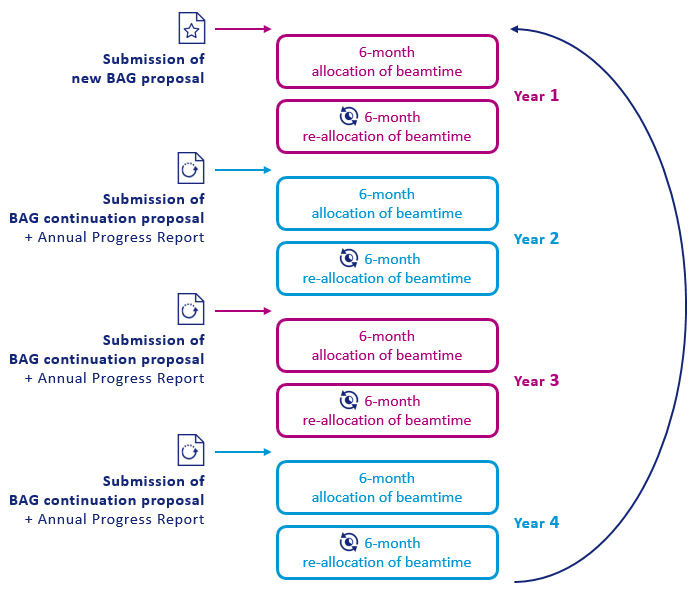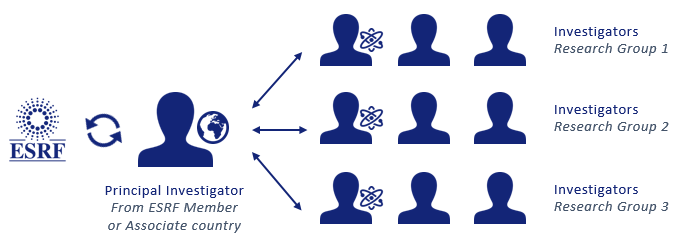BAG Proposals
A BAG (Block Allocation Group) proposal is a community access proposal grouping together a number of independent Principal Investigators (PIs) working in the same scientific field and sharing the same synchrotron instrument need (same beamline, same setup), who apply together as a consortium for a regular allocation of beamtime at the ESRF. The aim is to produce the most impactful science in a specific field by allowing the community to share the beamtime and decide itself on measurement priorities, made easier by regular beamtime allocation.
If successful, the ESRF will grant beamtime to the BAG whose members will then decide themselves how best to distribute the beamtime within the community and amongst the different projects. Apart from collaborating to share beamtime, the members will generally work independently and do not necessarily share results, although they may if they wish.
BAG proposals may be:
| Science-driven see the pilot “Historical Materials” BAG |
Technique-driven see the pilot “Shock” BAG |
Both science-driven and technique-driven BAGs are normally limited to using a maximum of 2 beamlines that each respond to a specific need (e.g. complementary techniques), ensuring the most efficient use of beamtime within any technical and safety constraints.
BAG proposals have been successfully used by the Structural Biology community at the ESRF for 20 years, grouping many projects into one beamtime session for a highly efficient use of beamtime. Many of the rules and rationales for MX BAGs have been used as a basis for the implementation of non-MX BAG proposals.
BAG proposals may be submitted twice a year at the regular proposal call deadlines, typically on 1st March and 10th September (or on the following Monday if these dates fall on a Friday, Saturday or Sunday). BAG proposals are evaluated and recommended for approval by the Beam Time Allocation Panels (BTAPs).
Beamline and beamtime request: should normally be targetted to a maximum of 2 beamlines (each responding to a specific need) and 18 shifts in total per 6-month allocation period.
If accepted:
| BAG status will be awarded for an initial period of 2 years, and with a maximum duration of 4 years. | |
| A fixed amount of beamtime is allocated every 6 months for the duration of the BAG. | |
| A BAG continuation proposal must be submitted each year following the initial acceptance. | |
| A new BAG proposal must be submitted after 4 years if the BAG wishes to continue its activity. |
Any modification in the beamtime request (in particular number of shifts per 6-month period, list of participants) should be made via the continuation proposal with clear justification.
Reporting and evaluation will be made on a yearly basis, with annual progress reports evaluated by the BTAPs. BAGs need to clearly demonstrate in their reports that this access route represents a clear added value as compared to individual standard proposals.
| The creation or conception of a BAG has to be discussed with the concerned beamline staff before submission of a proposal to check the technical and scientific feasibility. | |
| The need, advantages and added value of the BAG mechanism over the standard access mode for the research field in question needs to be clearly explained in the proposal. | |
| The management and organisation of the BAG (e.g. how the coordinator will distribute beamtime among partners, organisation of training sessions, requests for new partners, etc) needs to be set up when the BAG is being discussed and conceived within the community, and must be clearly described in the proposal. |
The ESRF will continue to welcome and review standard proposals in the same field from researchers who are not members of an existing BAG.
| However, standard proposals for work in the same field, that correspond to the scope of the BAG and request the same beamlines, may not be submitted by researchers who are part of an existing BAG – the work should be discussed and carried out within the framework of the BAG. |
Standard proposals in the same field may be submitted by BAG members for beamlines not allocated within the BAG or if the work cannot be done within the scope of the BAG (e.g. for scientific, technical or safety constraints).
The ESRF data policy currently allows all proposers (investigators) to access all the data collected under the proposal number. The users of the different experiment sessions have access to the data collected during the experiment session they participated in. The data are not accessible outside of this group during the 3-year embargo period, after which time they will become public according to the ESRF data policy. During the embargo period, the sharing of data with persons outside of this group and the management of additional access rights to third persons is the responsibility of the BAG Principal Investigator, as for all ESRF public proposals.
 Scientific Review
Scientific Review
BAG proposals are evaluated and recommended for approval by the corresponding BTAPs, according to the beamline(s) requested. The criteria for evaluation are:
| 1 | Relevance, impact, innovation, potential of the scientific and/or technological case |
| 2 | Added value of the BAG mechanism as opposed to access via standard proposals |
| 3 | Quality of the proposal and associated reports |
Approval will be made by the ESRF Management based on the BTAP recommendation, taking into account the compliance with the general criteria for BAG proposals and the amount of beamtime remaining for standard proposals on the concerned beamlines.
As a general rule, no more than 30% of the beamtime on a single beamline should be assigned to proposals involving a long-term commitment of beamtime such as Long Term Projects (LTPs), BAGs and HUBs, in order to leave sufficient time available for regular standard proposals. Management may decide on an exceptional basis to exceed this limit as necessary.
 Technical & Safety Review
Technical & Safety Review
This is made as for the standard access mechanism by the beamline scientists for the technical review and Safety Group for the safety review.
As for all ESRF proposals, each BAG must be identified with a single spokesperson, who is named as Principal Investigator, along with a list of Co-Investigators. The Principal Investigator must be affiliated to a scientific institution of an ESRF Member or Associate country. Exceptions from this provision require prior agreement from the ESRF Management.
The list of investigators must comprise at least 3 independent research groups, and may include groups from outside the ESRF Member or Associate countries. An ESRF scientist may participate as one of the scientific investigators in a BAG, but not as its Principal Investigator, as long as he/she is directly scientifically involved in the BAG research. It is not mandatory for an ESRF staff member to be part of a BAG, this is not one of the acceptance criteria.
The Principal Investigator is the single contact point for the ESRF and is responsible for submitting:
- The new and continuation BAG proposals
- The A-forms
- The BAG annual reports
The success and continuing pertinence of a BAG will be assessed via annual reports submitted by the BAG spokesperson.
Key items in the assessment are:
| Scientific publications emerging from the BAG and their impact | |
| Major challenges and questions answered | |
| Added value of the BAG scheme versus standard proposal applications |
and these must be clearly described in the report.
The annual report, along with the BAG continuation proposal, must be submitted for the proposal submission deadline on each yearly anniversary of the acceptance of the BAG. See the example cycles below.
Life Cycle of a BAG Proposal - Example 1
| Proposal Submission Deadline | Scheduling Period for Beamtime |
To Be Submitted |
| 1st March 2023 | 2023/II and 2024/I | New BAG Proposal |
| 1st March 2024 | 2024/II and 2025/I | Continuation BAG Proposal + Yearly Report (on 2023/II beamtime) |
| 1st March 2025 | 2025/II and 2026/I | Continuation BAG Proposal + Yearly Report (on 2024/I & 2024/II beamtime) |
| 1st March 2026 | 2026/II and 2027/I | Continuation BAG Proposal + Yearly Report (on 2025/I & 2025/II beamtime) |
| 1st March 2027 | Yearly Report (on 2026/I & 2026/II beamtime) |
The last 6-month beamtime allocation (2027/I in the example above) is not reported on but covers the 6-month period between the end of the BAG and any new beamtime allocation made in March 2027 that would start in 2027/II.
A new BAG proposal must be submitted for 1st March 2027 if the BAG wishes to request to carry on its activity at the ESRF.
Life Cycle of a BAG Proposal - Example 2
| Proposal Submission Deadline | Scheduling Period for Beamtime | To Be Submitted |
| 10th September 2023 | 2024/I and 2024/II | New BAG Proposal |
| 10th September 2024 | 2025/I and 2025/II | Continuation BAG Proposal + Yearly Report (on 2023/II beamtime) |
| 10th September 2025 | 2026/I and 2026/II | Continuation BAG Proposal + Yearly Report (on 2024/I & 2024/II beamtime) |
| 10th September 2026 | 2027/I and 2027/II | Continuation BAG Proposal + Yearly Report (on 2025/I & 2025/II beamtime) |
| 10th September 2027 | Yearly Report (on 2026/I & 2026/II beamtime) |
The last 6-month beamtime allocation (2027/II in the example above) is not reported on but covers the 6-month period between the end of the BAG and any new beamtime allocation made in September 2027 that would start in 2028/I.
A new BAG proposal must be submitted for 10th September 2027 if the BAG wishes to request to carry on its activity at the ESRF.
After the maximum 4-year period, the last annual report is submitted without a BAG continuation proposal. If the BAG members wish to continue their activity a new BAG proposal must be submitted.
BAG reports and continuation proposals will be evaluated along with other standard, long term and BAG proposals on the concerned beamlines by the BTAPs. The ESRF Management reserves the right to terminate a BAG proposal on recommendation by the BTAPs if the output and governance of the BAG is evaluated as non-satisfactory, or if the BAG is evaluated as less competitive than competing proposals on the concerned beamline(s). This will normally only be done after the initial 2-year period.
| In case of failure to submit an annual report, the BTAPs and ESRF Management reserve the right to stop the allocation of beamtime to the BAG. Failure to submit reports may affect the acceptance of future proposals at the ESRF by the applicants concerned. |
| 1 |
|
| 2 | |
| 3 | |
| 4 |
 Templates Required
Templates Required






